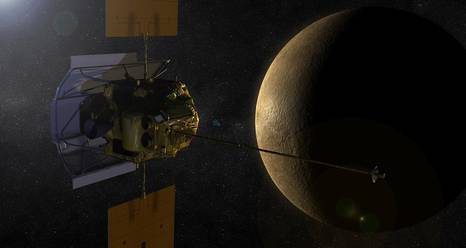
The MErcury Surface, Space ENvironment, GEochemistry, and Ranging (MESSENGER) spacecraft traveled more than six and a half years before it was inserted into orbit around Mercury on March 18, 2011. Image Credit: NASA/JHU APL/Carnegie Institution of Washington
WASHINGTON (PTI): After more than four years of orbiting Mercury, NASA's MESSENGER spacecraft will crash into the solar system's innermost planet in two weeks when it runs out of propellant.
NASA's MErcury Surface, Space ENvironment, GEochemistry, and Ranging (MESSENGER) spacecraft, which was launched in 2004, will impact the planet's surface, most likely on April 30, the US space agency said.
The spacecraft will impact Mercury at more than 3.91 kilometres per second on the side of the planet facing away from Earth.
Due to the expected location, engineers will be unable to view in real time the exact location of impact.
This week, mission operators in mission control at the Johns Hopkins University Applied Physics Laboratory (APL) in Laurel, Maryland, completed the fourth in a series of orbit correction manoeuvres designed to delay the spacecraft's impact into the surface of Mercury.
The last manoeuvre is scheduled for April 24.
"Following this last manoeuvre, we will finally declare the spacecraft out of propellant, as this manoeuvre will deplete nearly all of our remaining helium gas," said Daniel O'Shaughnessy, mission systems engineer at APL.
"At that point, the spacecraft will no longer be capable of fighting the downward push of the sun's gravity," he said.
Although Mercury is one of Earth's nearest planetary neighbours, little was known about the planet prior to the MESSENGER mission.
"While spacecraft operations will end, we are celebrating MESSENGER as more than a successful mission. It's the beginning of a longer journey to analyse the data that reveals all the scientific mysteries of Mercury," said John Grunsfeld, associate administrator for the Science Mission Directorate at NASA Headquarters in Washington.
The spacecraft travelled more than six and a half years before it was inserted into orbit around Mercury on March 18, 2011.
The prime mission was to orbit the planet and collect data for one Earth year. The spacecraft's healthy instruments, remaining fuel, and new questions raised by early findings resulted in two approved operations extensions, allowing the mission to continue for almost four years and resulting in more scientific firsts.
One key science finding in 2012 provided compelling support for the hypothesis that Mercury harbours abundant frozen water and other volatile materials in its permanently shadowed polar craters.
 Previous Article
Previous Article Next Article
Next Article











The Indian Air Force, in its flight trials evaluation report submitted before the Defence Ministry l..
view articleAn insight into the Medium Multi-Role Combat Aircraft competition...
view articleSky enthusiasts can now spot the International Space Station (ISS) commanded by Indian-American astr..
view article